Fellowship Blog: Our intern reveals what goes on behind the scenes at Lloyd’s List
Our intern visits Inmarsat, a company that has been providing satellite communications for the maritime community for nearly 40 years. The visit includes an interview with Drew Brandy, the senior vice-president, market strategy, on the topic of internet connectivity at sea and challenges that seafarers face in their everyday maritime life
Decent access to the internet at sea is the second most important element for seafarers after salary, says Inmarsat
Friday 28th September
Thank you
Today marks the last day of the Tom Leander Fellowship here at Lloyd’s List. I want to take this opportunity to thank all of those who made this fellowship special.
To Harry Theochari and Jane Lougher from Norton Rose Fulbright for sponsoring the second round of the fellowship and enabling someone with no shipping background to learn about the industry from scratch.
To Jos Standerwick from Maritime London for showing me the hub of London shipping market and introducing me to various maritime organisations and representatives.
To Andrew Linington from Nautilus International for letting me write a story on one of its historical flagship publications.
To Nicky Goldsbrough from the Shoreham port for inviting me to an amazing day at the port, packed with some incredibly thrilling activities, including driving a patrol vessel and getting on a Sennebogen crane.
To Mairead Ni Cheoinin from Seafarers UK for introducing me to one of the oldest maritime charities in the country.
To Claire Anwyl from DP World Southampton for providing me with an opportunity to explore the second largest container port in the country.
To Mark Warner from Inmarsat for showing me the inner works of one of the world’s largest mobile satellite companies.
Special thanks go to the Lloyd’s List team who have helped me with daily articles, build contacts and simply being kind and friendly throughout the fellowship.
To Helen Kelly for guiding me through till the very end, correcting my writings, giving me a regular feedback and answering each of my daft question with care and sincerity.
To Richard Meade for helping me out when I was following up on a tanker story and for giving me advice that I will always remember.
To Nidaa Bakhsh for being an incredible dry bulk teacher and for explaining complex details in a simple English. And for being a friend.
To Max Tingyao Lin for teaching me the tanker side of shipping.
To James Baker for taking the time to go through the history of containers shipping with me.
To Richard Clayton for sharing his knowledge and experience in maritime, especially with stories involving Japan.
To Linton Nightingale for spending some time with me on containers and being friendly.
To David Osler for introducing me to the investigative side of maritime journalism.
To Anastassios Adamopoulos for helping me with everything from writings, interviews, building contacts, attending events and more. This fellowship would not have been the same without your friendly support.
To Mike Harrison for suggesting stories for me to cover.
To Fred Williams for being friendly.
To Wayne Grady for your invaluable insight into the workings of journalism. I will always remember the tips you gave me.
I have learnt lots in such as short period of time, not only about the maritime sector in general but about writing articles, following house-style and how to interview or to prepare for an interview.
Thank you all for being patient and approachable. All the knowledge and experience gained throughout the fellowship have helped me want to become better in the field of journalism.
Friday 21st September
Inmarsat: inside the world’s biggest offshore network provider
This week, I visited Inmarsat, a mobile satellite company, where I met with key individuals from the maritime department, beginning with Mark Warner, the head of marketing communication.
Although the company’s activities extend beyond a maritime remit — including Inmarsat US and global government operation, enterprise and aviation — it is worth noting that it was founded upon the maritime premise when the connectivity between ships and shore, especially in the case of an emergency, became ever-more important in the late 1970s.
Inmarsat was first set up as a non-profit intergovernmental organisation at the behest of the International Maritime Organization and later saw part of its operational business privatised, with public safety obligations attached to the sale.
Having learnt about the history of Inmarsat, its origin and evolution, I met with Jennifer Eltringham, a maritime campaign executive, who gave me a walk-through of the marketing process. I learnt about the way in which marketing campaigns are launched, carried out and targeted at a specific audience.
For example, I was introduced to Inmarsat’s recently published report on superyacht connectivity, which addressed the increasing demand for satellite-delivered bandwidth to drive vessels. As Ms Eltringham explained, a targeted marketing campaign will only take place after a report on the subject is published to drum up interest. The marketing team will strategically select potential users by introducing content about the services offered by Inmarsat.
I had an opportunity to talk with Drew Brandy, senior vice-president, market strategy for Inmarsat Maritime. We briefly discussed a new report on digital connectivity at sea that was co-authored by number of institutions, including Royal Holloway, University of London, the Sailors’ Society and Inmarsat.
The purpose of the study was aimed at building a picture of how seafarers seek to establish a sense of community and group cohesion while at sea and how digital technology and mobile services support and challenge the establishment of these feelings.
“The use of the internet is the second most important element for seafarers after salary,” said Mr Brandy.
One of the study’s findings revealed a consensus among seafarers that the current availability of access to the internet was not enough to maintain satisfactory everyday relations with family and friends, especially during long periods spent at sea. Some ships limit their internet data allowance to 50MB per week, per person.
However, Mr Brandy noted the balancing act of providing internet access to seafarers in a “structured and measured way,” rather than offering an unlimited usage, which can lead to crews being distracted from ship operations.
The study suggests that increasing numbers of seafarers are deciding their future career choices based on the “internet deal” they are offered. It remains a challenge for Inmarsat and shipping companies to work out how they can accommodate seafarers in the best way possible through providing sustainable digital connectivity on board ships.
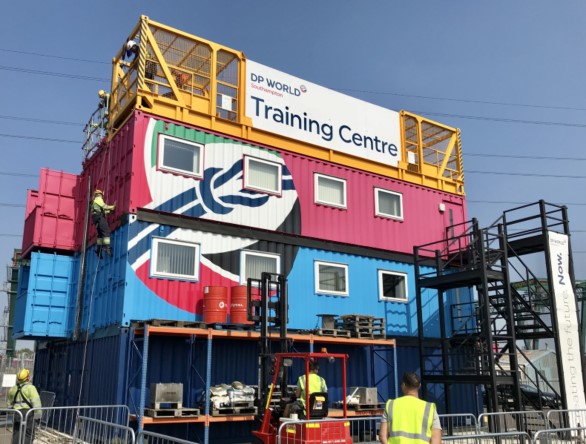
Friday 14th September
DP World Southampton: the hub of the supply chain
This week, I visited the port of Southampton and its operator DP World. It is the biggest port in the south coast of England.
According to the 2018 One Hundred Ports published by Lloyd’s List, Southampton ranked 85th in global container throughput at 2,040,000 teu, which makes it the second-largest container port in the country.
For three successive years, DP World Southampton has undergone growth, with a 4.24% boost in 2017 pushing it past the 2m teu mark for the first time.
The day began with the commercial manager Robert Freeman, who gave us an overview of DP World’s inner operation, its chronological progression, past successes and future challenges.
Mr Freeman said 2009 was a key moment for the DP World Southampton when newly appointed managing director Chris Lewis introduced a dynamic investment strategy by building new berths and cranes, turning the company’s fortunes around for the better.
Later in 2015, under a new business deal, DP World acquired the remaining 49% stake in DP World Southampton from Associated British Ports and extended its license agreement for a further 25 years until 2047.
Mr Freeman’s introduction was then followed by a port tour, which allowed us to visualise the actual scale of the operation.
As we drove along towards the berthing site, I was enthralled by the movement of straddle carriers — AT-ST walker alike — picking and carrying containers while straddling their load and connecting to the top lifting points.
Then there were Siam Container Terminals with massive ship-to-shore container cranes — cab 66m high and stretched 24 boxes across — loading and unloading containers in and out of vessels.
I was particularly drawn to bright fluorescent pink Ocean Network Express containers, also known as “the Alliance”, the 2017 realignment of the world’s major container consortia between K Line, MOL and NYK.
In response to the advent of the Alliance, Southampton port successfully negotiated potential turbulence from this realignment of those three behemoths and secured calls from all services.
The port also operates along the river, which makes it relatively unaffected by the changing weather.
The deep water along the berth enables large vessels such as the 16,020 teu CMA CGM Marco Polo or the 20,170 teu MOL Triumph to unload its containers.
The bigger the ships get, the deeper the water needs to be.
After the tour, I met with Pete Silsbury, training supervisor, and Ian McCrindle, training co-ordinator, at the training centre, where I was given the opportunity to learn about how crucial the role of training in the overall safety and sustainability of the port operation.
Key areas of training include crane operations, fork lifting and lashing containers.
Each year, the mandatory 40-day training session takes place at the beginning of the year to make sure that chances of an accident taking place are reduced.
In short, spending the day with DP World Southampton gave me an understanding of a supply chain that not only connects the maritime and land transport of goods but also among the people who enable such an operation to work round the clock.
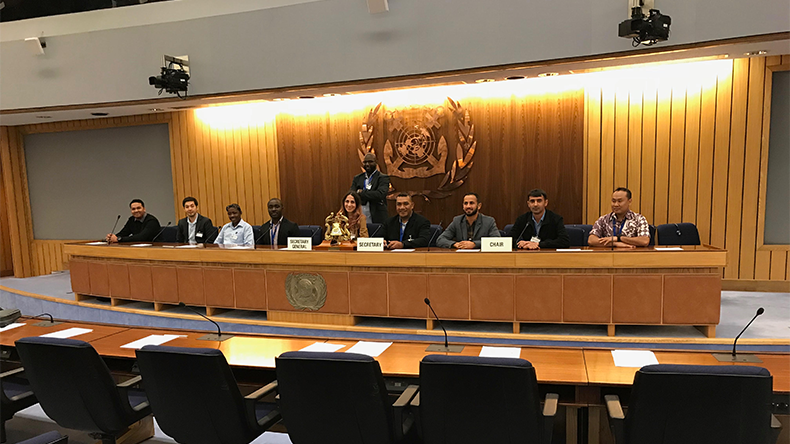
Friday 7th September
International Maritime Organization
This week I joined a tour, along with four offshore engineers from Egypt and 10 navy officers (or those who were en route to becoming one in the future), at the International Maritime Organization — the only UN org that has an HQ in London — with its building marked with a plaque celebrating 70th anniversary.
It was also a week that marked the world’s biggest international maritime trade fair in Hamburg, which was attended by the general secretary of the IMO, Kitack Lim.
After making a first stop at the general assembly hall — a place where financial arrangements are made and IMO council members elected — we were given a chance to see a coffee-break moment of an actual preliminary session for the sub-committee on carriage of cargoes and containers. The committee will take place next week.
Our tour guide, Tamara Vassilissin, also a principal external relations assistant at the IMO, explained the complex nature of the negotiation process that takes place during and between committee meetings. Arriving at consensus among 174 member states (with an island country named Nauru being the latest joining member) is no easy task. There are different values and interests at stake, especially when you consider the ability and methods to achieve tasks varying by country.
Followed by a presentation, I learnt that the membership fees paid by IMO member states are linked to the tonnage registered with their flag state administration.
It is flag states that are primarily responsible for implementing IMO regulations governing safety and environmental performance and therefore the world’s largest flag states come under obligation towards funding the costs of the global regulator.
However, a commensurate proportion of payment does not give those flag states an additional power to influence the outcome of the discussions, meaning that Panama and Liberia’s performance amounts to leverage equal to that of Japan or China.
Thursday 23rd August
Seafarers UK
Seafarers UK is one of the oldest international maritime charities and has been coming to the aid of people in the maritime community for over 100 years. Its history dates back to 1917 towards the end of the First World War, when an organisation named the Sailors’ Fund — a founding body of Seafarers UK — was first established by King George V.
At the time of war, the aim of the Sailors’ Fund was to ensure support for organisations that helped mariners in sickness and in distress, but also to aid the widows and orphans that those seafarers left behind.
The organisation has since helped British seafarers and their families who are in desperate need — across the Royal Navy, Merchant Navy and fishing fleets — providing vital funding for serving seafarers, families, dependents and communities, education and training for a career at sea and veteran seafarers.
At the office (which was beautifully decorated with paintings of Trafalgar and the Armada), I met Barry Bryant, director-general of Seafarers UK, who introduced me the idea of ‘sea blindness’: a general lack of awareness in maritime knowledge among the public.
Mr Bryant said that raising awareness and stimulating interest in the sea and the essential work done by seafarers was part of Seafarers UK’s core mission.
After speaking to Mr Bryant, I later learnt from fundraising manager Mairead Ni Cheoinin that in 2017 alone, Seafarers UK aided 163,217 individuals including merchants, young people, fishermen and others.
The organisation also committed to fund £3.5m worth of grants to areas such as education and training, port welfare services and many more. In total 88 grants were awarded to 60 national and international organisations.
One of the things that struck me the most from Mairead’s presentation was to recognise seafarers’ mental health and wellbeing issues. Often, emotional support for seafarers and their dependents are neglected by the wider maritime community.
For instance, it is often forgotten that seafarers can be out in the ocean on a fishing trawler for weeks, if not months, which leaves not only seafarers themselves but also their families or dependants in need for a mental and emotional support.
I later met grants manager Tina Barnes. who stressed the importance of sustaining successful campaigns that can continue to attract individuals and corporates so that grants that Seafarers UK receives can be allocated where the need is most.
As Seafarers UK looked back on its centenary, it appeared to me that the original spirit of charity — first recognised by King George V — was very much alive and well, striving to help and support current and future seafarers and the community at large.
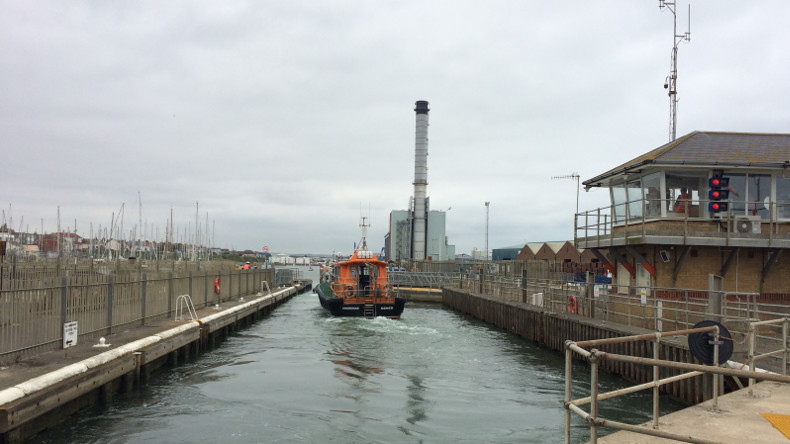
Wednesday 22nd August
Shoreham Port
My day at the Sussex port of Shoreham was spent in and out of the office with a group of very inspirational people.
The day began with a warm welcome from Nicky Goldsbrough, director of corporate services at Shoreham Port, who not only guided me throughout the day, introducing me to members of the team, but also taught me about port operations and even took me for lunch at a local seaside café.
Next came a safety induction given by Paul Johnson, director of compliance, who walked me through the Port Marine Safety Code, which is crucial in reducing risk to workers as low as is reasonably practicable.
I was also introduced to the Shoreham Port ‘Masterplan’, a strategy for the future development of the port, aimed at creating new commercial space, investing in port facilities and infrastructure, and developing capacity in order to achieve a target of 25% growth in trade over the next 20 years.
The highlight of last year was the expansion of the Shoreham Port tenant community through property acquisition, which saw its tenant companies increase from 100 to 150.
Paul also explained its status as a trust port, meaning that it sits as an independent statutory body controlled by an independent board and governed by its own unique legislation.
With no shareholders, the port reinvests financial surpluses for its own stakeholders.
After the induction, I spent two hours out on the port’s pilot cutter with the marine team. Assistant harbour master James Gray and other lockmasters gave me a tour around the locks, dry dock, harbour radio and pumping station.
It was great fun to see how the locks operate under the control of the lockmasters. It was clear that lockmasters face many challenges, including safety concerns related to being out in the sea patrolling and the need for flexible working hours that ensure workers can be stationed at the harbour 24/7.
During my time at the harbour radio, I witnessed a cargo vessel passing through the main lock and saw lockmasters adjusting the level of water within a lock, guiding the vessel to smoothly pass through.
I was also lucky enough to take the controls and drive one of the patrol vessels — under supervision — until I started straying too far offshore and James had to take my place.
I then came back into the office and met with Katie MacAllister, Shoreham Port’s marketing and communications manager, and Georgia Ellis, marketing and communications executive, where I learned about the port’s communication strategy, via its website and social media campaigns.
In 2017, Shoreham saw its social media engagement grow by 270% across all platforms, thanks to successful campaigns such as the Kaizen campaign which encouraged staff to think about continuous improvement in the workplace.
After lunch with Nicky and Georgia, I met Tony Parker, director of engineering. As Nicky had earlier mentioned to me, he knows everything there is to know about the port, from the ancient history of Saxons landing at the mouth of the River Adur, to Brexit impacting the port economy.
It was a great opportunity to explore a grand site like Shoreham Port (there are 27 berths, 13 of which are either leased out or privately owned) with an expert who knew the answers to all my questions.
One of the discoveries that stood out for me was the site’s use of wind turbines, which match the energy demand of the port’s pump house to which they are connected.
Tony explained that the turbines feed power to the pump house, located on the southern side of the locks, and are essential to the operation of the port.
Daily use of the locks results in water being lost back to the sea and water levels in the basin being reduced. It is crucial for water to be pumped back into the basin, a function that the pump house provides.
It is expected that the turbines’ annual power generation will slightly exceed requirements.
Shoreham Port is also supplied by a solar energy, making it a major centre for renewable energy and one of the most environmentally-friendly ports in the country.
Having travelled across the site with Tony, I met Dave Bunker, Shoreham’s general manager of operations, who first took me to see the quayside, where its main aggregate — namely steel, timber and agricultural goods — are stored.
Dave then allowed me to climb up one of the port’s Sennebogen cranes and sit in the cab with the operators to get an idea of what it is like to work up there.
The opportunity to have so much direct experience of port life — be it driving a patrol vessel or literally having an overview of the port from the crane’s cab — was an amazing privilege.
Thank you Nicky for arranging such an amazing day. Ultimately, it was the people of Shoreham Port that made my time there so special.
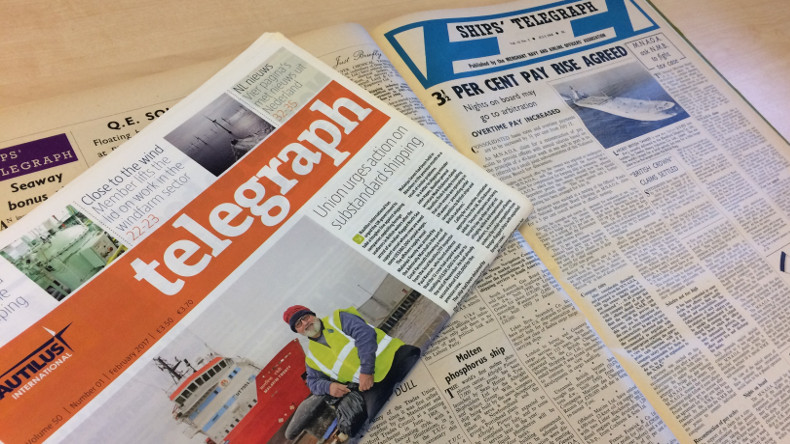
Telegraph is the monthly flagship publication of maritime trade union Nautilus.
Monday 20th and Tuesday 21st August
Nautilus International
As one of the major international maritime trade unions, Nautilus’s 22,000 members work at sea and ashore in all the waterborne transport sectors. As well as in the UK, the union has offices in the Netherlands and Switzerland.
Day 1
On Monday I began the day at Nautilus International’s office in East London, learning about the inner workings of a maritime trade union.
Nautilus represents various members across the sector, including shipmasters, officers, cadets, yacht crew, vessel traffic services officers, harbourmasters, river boatmen, nautical college lecturers, maritime lawyers and even ship-based medical personnel.
Nautilus International traces its history back to 1857, when the Mercantile Marine Service Association was founded in the UK in response to the provisions of the 1850 Merchant Shipping Act.
Over the decades various bodies representing seafarers and inland navigation workers in three countries — the UK, the Netherlands and Switzerland — have been established. They later joined together in the interests of their members, resulting eventually in the organisation we now know as Nautilus International.
At the office I began writing a summary report about an offshore safety conference which was attended by Nautilus’ national organiser Steve Doran.
The conference was co-hosted by the Offshore Coordinating Group, which consists of various groups within the maritime and shipping industry. From the UK these include Unite the Union, the National Union of Rail, Maritime and Transport Workers, GMB, Nautilus International and the British Airline Pilots’ Association. The Danish union, Dansk Metal, and the Norwegian union, Industri Energi, were among representatives from outside the UK.
During a speech at the event, Steve flagged future safety issues for the offshore energy sector and reflected on the 30 years since the Piper Alpha explosion — the 1988 catastrophe that claimed 167 lives and is remembered as the world’s worst offshore oil rig disaster.
Steve told the audience that the 1980s was marked by accidents that were the direct result of a rampant free market cost-cutting philosophy that put profits before safety and short-term rewards ahead of long-term needs.
Other tragic maritime incidents in the 1980s included the 1987 Herald of Free Enterprise ferry disaster in Zeebrugge, the 1989 Marchioness passenger boat accident in the River Thames and the 1983 blowout on the offshore oil rig Ocean Odyssey.
Day 2
Tuesday began with a story to write for the Telegraph, Nautilus’s flagship magazine.
Andrew Linington, director of campaigns and communications for Nautilus, suggested I write a story about the delivery of an oil tanker from Japan to Britain that happened in 1968, based on an archived story from the Telegraph that he pulled out for me.
During the late 1950s and 1960s — due to the Suez crisis and a subsequent blockade of the canal — shipbuilders were forced to build larger carriers that could handle increased amounts of oil. Vessels were forced to sail around the Cape of Good Hope, which meant longer transit and increased fuel consumption.
Learning about the historical context of the story allowed me to understand why Britain had ordered a larger vessel from Japan.
I would like to thank Andrew, Deborah and other members of Nautilus for being so friendly and allowing me to be part of the team, albeit for a short period of time. Special thanks go to Deborah for teaching me the art of website management skills.
Friday 13th August
Each year, Lloyd’s List issues comprehensive information and key characteristics on international container ports; also known as One Hundred Container Ports where we determine the top 100 international container ports, based on the performance of each port in throughput and percentage terms, country or regional contributions and previous rankings.
I was involved in providing supplementary materials for the new 2018 entries, in particular, focused on five ports: Port of Hong Kong (ranked 6th in 2017), Port of London (ranked 66th in 2017), Port Klang in Malaysia (ranked 11th in 2017), Port Said in Egypt (ranked 49th in 2017) and Port of Singapore (ranked 2nd in 2017).
This week, in addition to contributing to that information on 100 leading global ports, I also wrote a story on the US blacklisting of Chinese shipping firms and a Russian port agency, due to their violation of sanctions against North Korea.
This was yet another instance of the overlap of shipping and international politics, whereby, in this particular case, North Korea apparently is collaborating with China and Russia in order to evade sanctions imposed by the US and the UN.
It was a further reminder of the way a nation's political will so often expresses itself through their maritime policies.
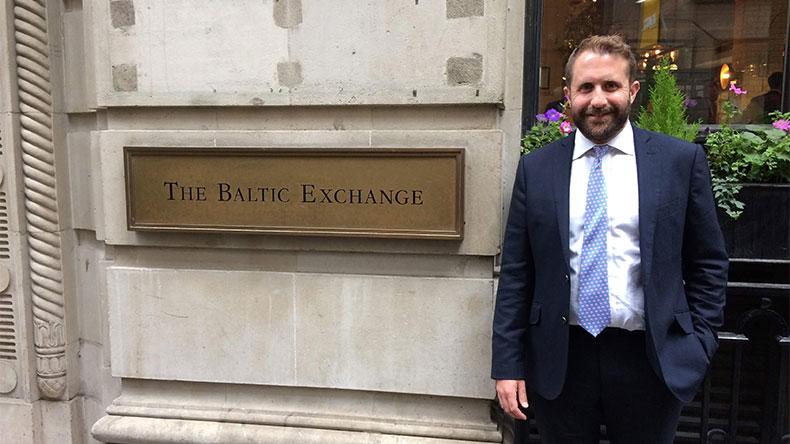
Jos Standerwick, chief executive of Maritime London, at the door to the Baltic Exchange.
Friday 10th August
Maritime London
This week, I visited Maritime London, the Baltic Exchange, the Federation of National Associations of Ship Brokers and Agents, Lloyd’s Market Association, Greek Shipping Co-operation Committee and London Maritime Arbitrators Association, where I witnessed the intricacy of London’s wider shipping network.
I began by meeting Jos Standerwick, chief executive of Maritime London, and Janet Sykes, the chief operating officer of the Baltic Exchange. They both had a lot to tell me about their institutions’ history and what services they offer.
The history of the Baltic Exchange traces its roots back to 1744 (only 10 years after the launch of Lloyd’s List) in the Virginia and Baltic Coffee House, London. Coffee houses were important places for merchants and shipowners to exchange market-wide information.
The old building of the Baltic Exchange became the last remaining face-to-face trading floor in the City of London until it effectively ceased in 1992 due to the explosion of a bomb placed by the Provisional IRA. The former sites of the Baltic Exchange and Chamber of Shipping are now home to the Gherkin, a commercial skyscraper.
Hearing about the history of the Baltic Exchange, it was important for me to understand the context in which the way maritime and shipping industry operates to this day in London.
After my visit to the Maritime London office, I walked next door to the Federation of National Associations of Ship Brokers and Agents. The general manager Jonathan Williams gave me an introduction the difference between the role of a ship agent and a shipbroker. The former represents the interests of the shipowner or charterer while the ship is in port. The latter acts as an intermediary between the shipowner and charterer or the buyers and sellers of ships.
After leaving the Baltic Exchange, I followed Mr Standerwick to meet Neil Roberts, the head of marine underwriting at Lloyd’s Market Association. Mr Roberts explained the role of an underwriter is to offer business insight and technical support to achieve market consensus, where appropriate, and to inform and influence market oversight decisions. His underwriting team represents a long list of marine issues ranging from hull, war, liability and rig, cargo, specie, joint excess loss and all the other marine sectors that one can imagine.
At the end of the tour, Mr Roberts took us to the old heritage site of Lloyd’s Market Association, where we encountered historically important marine exhibits, including a collection of swords that belonged to Admiral Nelson.
Friday 3rd August
I spent the week with Nidaa Bakhsh, our senior markets reporter, engrossed in the dry bulk industry. First came an intro to the Baltic Exchange, a database furnishing freight market information for the trading and settlement of physical and derivative contracts.
But first I needed a vocabulary lesson, including basic terms, such as “spot price”, “forward curve”, as well as names of vessels, like “panamax”, “capesize”, the list goes on....
In a later story related to Diana Shipping, a major dry bulk owner, those terms came in useful for explaining market trends, quarterly and annual projections. It was also useful for understanding why Diana managed to get double the rate for a capesize charter compared with its previous contract.
As I understand, this year has seen an important rebound for dry bulk freight rates after hitting lows in 2016.
This April, however, saw a steep drop, especially in the capesize market, because of limited cargoes due to weather-related disruptions at various mines and later a trucker’s strike in Brazil that curtailed shipments.
While those issues were temporary, challenges remain: namely the ever-present threat of a full-scale global trade war.But demand growth has improved, outpacing vessel supply. Balancing the market seems to be key.
Monday 30th July
My internship has taken me into unexpected waters within the maritime industry. This week, I began with a story on piracy in the southern Philippines. I am learning how crucial it is to raise international awareness of pressing maritime security issues. Moreover, such concerns relate to my former studies in International Relations.
For the second story of the week, I wrote about delays in construction of Mombasa’s new cruise terminal. Anastassios Adamopoulos kindly facilitated contacts with the Kenya Ports Authority, and those contacts were crucial for the development of the story. I once again became aware of the necessity of developing the art of firstly, being able to ask the RIGHT questions, and secondly, liaising skilfully and diplomatically with the relevant parties, in order to produce a comprehensive article.
My final article of the week was to write up a casualty report on a vessel collision off northern Japan. I started off by calling the Japanese coast guard to confirm details of the incident, which had been reported earlier by a Japanese newspaper. Thanks to Lloyd’s List Intelligence and its automatic identification system — updated every 2 hours — I was able to verify the location of the vessel.
Friday 20th July
It was the third Monday of my internship and I was given a chance to sit down with Nidaa Bakhsh, our senior markets reporter, who taught me how to construct a news article from scratch. It is no surprise that each journalist has their own ways of shaping a story. I was grateful to Nidaa for teaching me how to trace a story, find related articles, get a quote, and perhaps most importantly, familiarise myself with background stories and roles of each actor involved. Nidaa also encouraged me to try and find a focus on a topic that could be of my own interest. She introduced me to her with a story on South Korea’s Polaris Shipping, a company that owned and operated VLOC Stellar Daisy, which split and sank in high seas off Uruguay March last year.
On Tuesday, I picked up a story on South Korean shipbuilding (At this point, ‘South Korea’ had become my buzzword), where the shipyards were struggling against Chinese competitors. In the hope of giving a full picture to the story, I recalled the teachings from the day before and attempted to apply the methods I learnt from Nidaa.
Thursday was yet another adventure, as I met with one of the representatives of the Australian Maritime Safety Authority Michelle Grech. I was passing by the International Maritime Organization headquarters with Anastassios Adamopoulos, our reporter at Lloyd’s List, who kindly took me to see how interviews are conducted. Observing the interview helped me understand how one could seek answers from interviewees. I recalled what Richard Meade, our managing editor, told me on my first day; be unafraid of asking wrong questions.
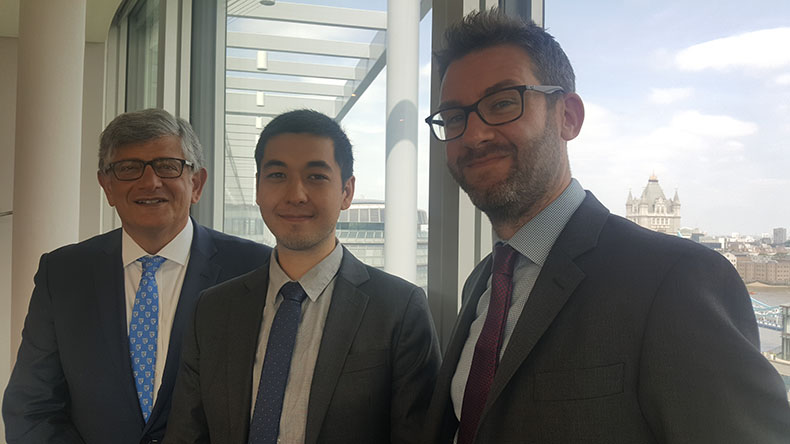
Harry Theochari of Norton Rose Fulbright, Theo Cohn and Lloyd's List Editor Richard Meade.
Friday 13th July
The Tom Leander Internship is a three-month work experience with Lloyd’s List, the world’s oldest continuously running journal, which dates back to 1734.
This internship aims to provide aspiring maritime journalists, such as myself, a fast-paced and deadline-orientated news writing experience, with a unique touch on training placements at key organisations including Inmarsat, Oders Berndtson, Seafarers UK, and Elabor8.
I was lucky enough to have found this amazing opportunity while I was browsing online for a journalism-related graduate job. The three-month role started on July 2 and will last until the end of September.
The main reason I applied for this internship was due to my interest in pursuing a career in journalism. At the same time, I also want to specialise in a certain field and the maritime industry seemed incredibly appealing.
On the first day, I was assigned the job of turning a press release into a news article, which was challenging, but also a very rewarding experience. I was shown how to produce a news story, to judge whether a press release is worth turning into a news or not, and how to apply a particular house style.
On the second day, I was invited to a welcome event hosted by Norton Rose Fulbright, one of the sponsors of this internship. The event was attended by representatives of the shipping industry and many other bodies. It was a real eye-opener to see how industries — in spite of their very differences — are intricately intertwined composites of maritime transportation.
Harry Theochari, the global head of transport at Norton Rose Fulbright, offered a reminder of what this internship stands and former Lloyd’s List editor Tom Leander’s invaluable service to journalism.
For the first week of the internship, I turned around three press releases into news articles.
The first was about a French port investing in infrastructure upgrades; the second one covered a ship recycling project in Bangladesh; and the third concerned a Moroccan transhipment hub increasing their container throughput.
On the second day of the second week, I was invited for an interview training workshop organised by the talent acquisition team at Informa — Lloyd’s List’s parent company — to learn about skills that are crucial to preparing for an interview and how one could best perform in such environment.
Towards the end of the second week, I was invited to attend a talk held by Nick Fallon, the company’s managing director, who shared with us his view on pursuing a career, which included his personal career progression that led him to become a successful executive.
So far, I’m gaining a lot of experience and insight, particularly about how little knowledge I have!
From the classification of ships, regulatory bodies, and the operation of ports, I had never thought the shipping industry could be so diverse and actually... enthralling.
I am now engrossed in fabulous stories such as Richard Clayton’s prognosis of Japan’s future shipping industry or James Baker’s introduction to container shipping. I’m fascinated by this industry and looking forward to writing up many more stories to come.
Finally, I would like to take this opportunity to thank everyone for their time, effort, goodwill and kindness that has made this second round of the Tom Leander Fellow Internship happen.

